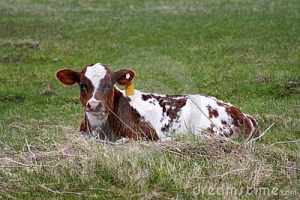World Dairy
The Canadian Dairy Industry at a Glance

…Genetics
The Canadian dairy industry is famous for the superior genetic quality of its herd as well as its strong dairy cattle improvement and genetic evaluation programs.
The Holstein breed is the most common dairy breed (93% of the dairy herd); Ayrshire, Brown Swiss, Canadienne, Guernsey, Jersey and Milking Shorthorn breeds are also found on Canadian farms.
In 2010, Canadian cows enrolled on official milk recording programs produced on average 9,768 kg of milk per lactation (305 days) with an average content of 3.79% fat and 3.21% protein.
Canada is at the forefront of new and innovative research into dairy genetics. Through genotyping, geneticists determine animals DNA profiles and are currently estimating genomic evaluations for over 60 different traits. Genomic evaluations published by the Canadian Dairy Network (CDN) are calculated using imputed genotypes (3K and 50K) since October 2010.
Canada is a net exporter of dairy animal genetics (bovine embryos, semen and live dairy cattle). Canadian dairy genetics, exported to 98 different countries worldwide, totalled about $101 million in 2010. Canada's dairy bull semen exports represent a 20% market share of global exports. In 2010, Canadian live breeding cattle were primarily exported to the United States, accounting for 58% of total dairy cattle exports.
…Manufacturing of Dairy Products
The dairy processing sector is relatively concentrated. 15% of Canadian plants are owned by the three largest processors in the country (Saputo, Agropur and Parmalat), processing close to 80% of the total raw milk produced in Canada.
The fluid milk market (table milk and fresh cream) represents 39% of milk production or 29.5 million hectolitres, while the market for manufactured dairy products such as butter, cheese, yogurt and ice cream accounts for 61% of production or 47 million hectolitres of milk.
Canada's dairy products are as diverse as its land and people. From aged cheddar cheese to specialty cheeses, ice cream and dairy drinks, the selection is vast and varied.
Although still a relatively young sector, the Canadian cheese industry has entered a maturity phase, evidenced by its know-how developed through extensive cheese making traditions and the diversity of its 667 varieties of cheese (cow, goat and ewe). Many of these are recognized around the world for their quality and taste. Â
Out of these 667 distinct varieties of Canadian cheese:
- 477 varieties are produced in Quebec (71%)
- 125 varieties are produced in Ontario (19%)
- 65 varieties are produced in other Canadian provinces (10%)
Canadian dairy innovation is built on the industry's expertise in research and development. Canada's scientists are leaders in developing and transferring new technologies. An example of Canadian innovation is the development of a robust line of functional dairy products. Already several products have been developed, such as pre- and pro-biotic yogurts, yogurts containing plant sterols, ultra filtered milk, and products containing Omega-3 fatty acids. Canadians looking for healthy and nutritional products will continue to have access to an ever expanding range of quality Canadian dairy products that will meet their needs.
Production of organic milk, although fairly limited, is steadily increasing in Canada reaching
87 million litres in 2009/10; more than double what is was five years ago.
Canada has been a net importer of dairy products since 2000. The European Union is the largest exporter to Canada followed by the United States and then New Zealand. The top two imported products are specialty cheeses and milk protein ingredients.
…Quality and safety
Strict quality standards applied throughout Canada’s production and processing chain contribute to the excellent reputation of Canadian dairy products. A significant number of dairy plants are HACCP and/or ISO certified.
The on-farm food safety program “Canadian Quality Milk†is a HACCP-based program developed by Dairy Farmers of Canada and certified by the Canadian Food Inspection Agency (CFIA). Its objective is to help producers prevent and reduce food safety hazards and risks on their farms, while improving milk quality at the farm level. As such, it serves to assure consumers that Canadian milk is produced in a safe manner.
CFIA is responsible for setting standards for dairy products, for inspecting plants under federal jurisdiction, and for regulating packaging and labelling. CFIA also enforces veterinary health programs and ensures the safety of dairy products.
Thanks to the strict standards in place, several serious cattle diseases have been eradicated from Canadian dairy herds. CFIA ensures the maintenance of national eradication programs and also ensures the mandatory control and monitoring in accordance with international agreements, particularly OIE agreements, protecting Canadian livestock from serious diseases that could restrict trade or pose a risk to human health.
Also, the CFIA and producers are working together to develop national voluntary farm level biosecurity standards for the dairy industry. Developing and implementing such standards will benefit industry and government by reducing the risks and costs associated with introducing, amplifying and disseminating disease at the farm level.
Sound welfare practices for housing, management, transportation and other animal husbandry practices are in place with the Code of Practice of the Care and Handling of Dairy Cattle developed nationally and circulated to all Canadian milk producers in 2009.
Federal, provincial and territorial governments, in partnership with industry, have made the development of a full traceability system a priority in Canada. Traceability systems in Canada are based on three basic elements: animal identification, animal movement and premises identification. The National Livestock Identification for Dairy (NLID) system coordinates the identification of all dairy animals in Canada. This means all newborn animals, male and female are tagged using the same system.
The Canadian dairy industry is currently developing a comprehensive strategy on environmental sustainability related to climate change, aimed at reducing greenhouse gas emission (GHG) in an increasingly efficient Canadian dairy industry.
…Associations and organizations related to the dairy sector
Government and industry partners work in close cooperation to coordinate the movement of milk from the farm to the consumer. Dairy Farmers of Canada (DFC), the Dairy Processors Association of Canada (DPAC), the Canadian Dairy Commission (CDC), provincial marketing boards, dairy processing companies and cooperatives and, Agriculture and Agri-Food Canada (AAFC) all work as partners to ensure a strong and dynamic industry.
The CDC supports the industry by implementing national policies for milk production, by assessing changes in demand and production of milk, by coordinating the pooling of milk revenue and the market-sharing systems and managing surplus removal activities.
Research and development of new dairy products are the result of strategic alliances among producers, processors, universities, and federal and provincial research centres.
As a world leader in food safety, Canada strives to be an international leader in innovation and environmental protection. High standards in these fields contribute to the quality of Canadian milk and dairy products, and meet the demands of consumers in Canada and abroad.
Pierre Doyle, P.Ag.
Assistant Director, Dairy Section, Animal Industry Division
Agriculture and Agri-Food Canada
1341 Baseline Road, T5-2-353
Ottawa, Ontario K1A 0C5
Tel.: (613) 773-0235
Fax: (613) 773-0200
E-mail: cdicinfo@agr.gc.ca
Or
Chantal Paul
Chief, Communication Services
Canadian Dairy Commission
960 Carling Avenue, Building No.55
Ottawa, Ontario
K1A 0Z2
Tel.: (613) 792-2040
Fax: (613) 792-2009
E-mail: cdc-ccl@agr.gc.ca























